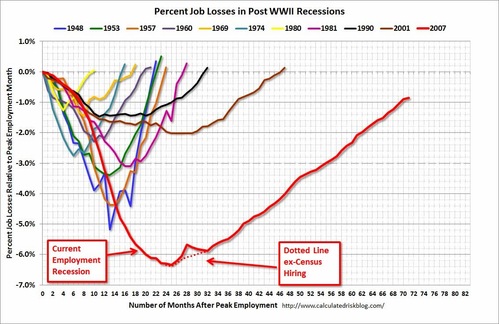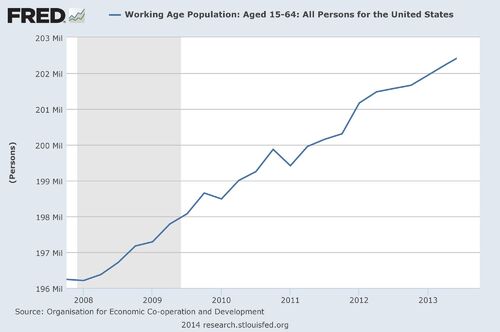Breakeven
The US jobs report on Friday was only exceptional in one regard. It wasn't the 192k jobs added in March to the US economy. It wasn't the paltry 1k manufacturing jobs created.
What was exceptional was the fact that we have now recovered all of the jobs lost during the "Great Recession".[i]
It may seem like a nice time to rejoice and declare victory on the jobs front. Unfortunately, reality gets in the way of the jobs celebration.
One, the time it's taken to recover to this point has been the longest in post-WWII recession history.[ii] That means the economy has underperformed for a very long period of time.

Two, the breakeven point does not reflect the 6 million new entrants that have reached working age since 2008 when the recession began.[iii]

Finally, the addition of 192k jobs simply brings us back to a slow growth trend. As observed by the red line in the graph below, the rate of job growth in this recovery remains flat versus more rapid growth prior to 2007.[iv]
While breakeven feels good, especially when we were down 8.8 millions of jobs from the peak, it is not likely to change the Fed's stance on taper reductions.[v] The only thing breakeven confirms is that this economy continues to need extraordinary measures to help it lift beyond its current flat trend.
If you have questions or comments, please let us know as we always appreciate your feedback. You can get in touch with us via Twitter, Facebook, or you can email me directly. For additional information on this, please visit our website.
Tim Phillips, CEO – Phillips & Company
Jeff Paul, Senior Investment Analyst – Phillips & Company
[i] Kurtz, Annalyn. (Apr 4, 2014). “Private sector jobs finally back to 2008 peak, but…”. CNNMoney.com.
[ii] McBride, Bill. (Jan 10, 2014). “December Employment Report: 74,000 Jobs, 6.7% Unemployment Rate”. Calculated RISK.
[iii] Federal Reserve Economic Data.
[iv] Federal Reserve Economic Data.
[v] JP Morgan. (Apr 2014). Guide to the Markets. p. 24.